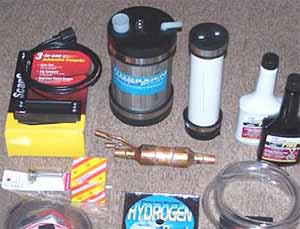 The hydrogen gas saver is a device that electrolyzes water and injects the resulting H2 (hydrogen) and O (oxygen) into the vehicle’s intake. This results in increased gas mileage, increased torque, decreased emissions and a cleaner burn inside the engine reducing deposits and general wear.
The hydrogen gas saver is a device that electrolyzes water and injects the resulting H2 (hydrogen) and O (oxygen) into the vehicle’s intake. This results in increased gas mileage, increased torque, decreased emissions and a cleaner burn inside the engine reducing deposits and general wear.
I’ve talked about a specific hydrogen gas saver here and there over the past few months, but this is a subject that just won’t go away, especially with gasoline prices ever rising along with the price of a barrel of oil.
Also called hydrogen generators, boosters or HHO devices, the hydrogen gas savers are based upon simple electrolysis of water. Some of the hydrogen gas savers require an electrolyte be added to aid in the conduction of electricity. The hydrogen gas saver has actually been around for years, but along with it so have the run your car on water scams that have made many people skeptical of these devices. Separating the scams from the legitimate hydrogen gas saver is the goal here.
For the do-it-yourselfer there are a few DIY ebooks that can help you put together a hydrogen gas saver inexpensively and with parts found at most hardware stores. For those who don’t wish to do it themselves there are several commercial units available. The National Hydrogen Association actually lists three members who sell hydrogen gas savers including the Canadian Hydrogen Energy Company, Hy-Drive Technologies and HyPower Fuel.
In fact, the U. S. Department of Energy lists Hy-Drive Technologies on the government website as a major player in hydrogen gas saver technology. In the past two months, I’ve told you how to run your car on water and talked about hydrogen generators for my car as a viable resource for increasing gas mileage and cutting emissions.
One of the differences I see between the low cost or DIY units and the high cost hydrogen gas savers is that the higher cost units usually use the car’s onboard computer to optimize the flow of hydrogen gas in with the gasoline or diesel mix. This one feature of the higher cost devices can mean gas savings of over 50-percent. The lower cost or DIY hydrogen gas savers are usually in the range of 15 to 35-percent in savings depending upon driving conditions.
There are a couple of good videos here and there that show first how massive amounts of hydrogen can be produced from water and second what this looks like under the hood. With gasoline prices the way they are, many people are taking it into their own hands to save gas now rather than waiting for the Big 6 automakers or oil companies to get around to it. Most people just don’t know that this option is available.
Leave a Reply
You must be logged in to post a comment.